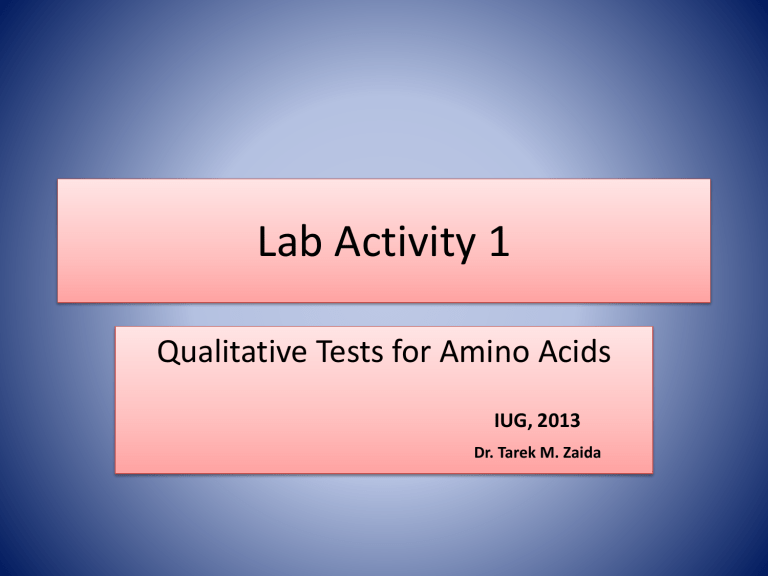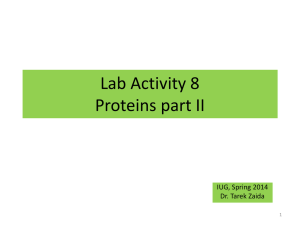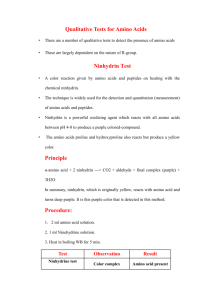Procedure
advertisement

Lab Activity 1 Qualitative Tests for Amino Acids IUG, 2013 Dr. Tarek M. Zaida Main Classes of food ? • Carbohydrates: (readily available energy resources) • Lipids: (principal energy reserves) • Proteins: (Source of energy for growth & cellular maintenace) Proteins are…. • The most important cell content after water • Are either functional or structural • Macromolecules made up of amino acids, connected together by peptide bonds. Peptide bond: Amide bond, formed between COOH & -NH2 of 2 adjacent amino acids. Amino acids Proteins are made up of 20 A.A. All of them have the same general structural formula shown above, however they are different in the R- group (side chain). Classification of amino acids • Non-essential.. Are synthesized by the body • Essential.. (Valine, Leucine, Isoleucine, Methionine, Threonine, Tryptophan, Phenylalanine, Lysine, Histidine) What amino acids chemical reactions are due to? 1. Amphoteric nature 2. R-group or side chain The accessibility of certain functional groups to the reagent will determine the intensity of the product color. The color intensity varies among proteins and is proportional to the number of reacting functional, or free groups present. A.A in acidic, neutral, and basic solutions Experiments • A.A can be characterized qualitatively by using several dyes that will react with certain groups of the A.A. Seven Tests: 1. Ninhydrin 2. Biuret 3. Millon’s 4. Xanthoproteic 5. Hopkin’s- Cole 6. Sulfur 7. Sakaguchi 1. Ninhydrin Test • For amino acids containing a free NH2 & free COOH. • Reaction with ninhydrin to produce a colored product. 1. When NH2 is attached to α-C on the amino acid’s carbon chain, the amino group’s N is part of a blue-purple product. 2. Amino acids that have N-H (a secondary amino group (e.g. proline) also react with ninhydrin, but they yield a yellow product. Reaction of A.A with Ninhydrin Procedure.. 1. Label 6 cleaned, drained test tubes with the names of the following solutions: 2 % glycine, 1 % tyrosine, 2 % proline, 2 % casein, 2 % gelatin, 2 % albumin. 2. Add 15 drops of each solution in the corresponding test tube. 3. To each of the test tubes add 5 drops of 0.5 % ninhydrin reagent solution. 4. Place the test tubes into the boiling-water bath for 5 minutes. Remove the test tubes from the water bath and place then in a test tube rack. Record your observations! 2. Biuret • For detecting peptide bonds (hence peptides or proteins).. • How it works? • The copper atoms of Biuret solution (CuSO4 ) in a basic environment will react with peptide bonds (-CO ---NH) to form a chelate of a deep violet color, indicating the presence of proteins. • A light pink color indicates the presence of peptides.. Biuret complex with proteins… Procedure.. 1. To 1 ml of a solution containing protein add 4 ml of a biuret reagent. 2. Mix well, then let to stand at RT for about 30 min. 3. Record your abservations! 3. Millon’s • Any compound containing a phenolic hydroxyl group will give a positive result with Millon’s reagent. • Cosequently.. • Proteins containing tyrosine will give a positive test of a pink to dark-red color • Note: Some proteins will initially form a white precipitate that will turn red when heated. Procedure.. 1. 2 ml of 2% casein, 2% egg albumin, and 0.1 M tyrosine add 3 drops of Millon's reagent. 2. Immerse the tubes in a boiling water bath for 5 minutes. 3. Cool the tubes down. Record the colors formed. 4. Xanthoproteic For detection of aromatic groups, derivative of benzene, (hence aromaric amino acids). These aromatic groups can undergo reactions characteristic of benzene, and its derivatives. One such a characteristic reaction for benzene is: Nitration The amino acids tyrosine and tryptophan contain activated benzene rings and readily undergo nitration, while phenylalanine does not contain a readily activated benzene ring. a. Act. tyrosine b. Act. Tryptophan Procedure... 1. Add 1 ml of a concentrated HNO3 in a test tube containing 2 ml of a protein solution. 2. The formed white precipitate, will turn yellow upon heating, and finally will dissolve giving a yellow color to the solution. 3. Cool the solution down. Carefully add 3 ml of 6 N NaOH. The yellow color turns orange. 5. Hopkins-Cole (Glyoxylic Acid Reaction) • Specific for tryptophan (the only amino acid containing indole group) • Reacting with a glyoxylic acid in the presence of a strong acid, the indole ring forms a violet cyclic product. • The protein solution is hydrolyzed by conc. H2SO4 at the solution interface. • Once the tryptophan is free, it reacts with glyoxylic acid to form violet product. Indole Glyoxylic acid Procedure.. 1. In a test tube, add to 2 ml of the solution under examination, an equal volume of Hopkins- Cole reagent and mix thoroughly. • Incline the tube and let 5 to 6 ml of conc. H2S04 acid flow slowly down the side of the test tube, thus forming a reddish - violet ring at the interface of the two layers. That indicates the presence of tryptophan. 6. Sulfur Test • For the detection of sulfur-containing amino acids such as cysteine. • Is done by converting S to an inorganic sulfide ( S2-) through cleavage by a base. • When the resulting solution is combined with lead acetate (CH3COOPb), a black precipitate of lead sulfide is formed. Sulfur-containing protein ----> NaOH----> S2- ---Pb2+----> PbS Cysteine Procedure.. 1. Place 1 ml of 2% casein, 2% egg albumin, 2% peptone, 2% gelatine and 0.1 M cysteine into separate, labeled test tubes. 2. Add 2 ml of 10 % aqueous sodium hydroxide. Add 5 drops of 10 % lead acetate solution. 3. Stopper the tubes and shake them. Remove the stoppers and heat in a boiling water bath for 5 minutes. Cool and record the results. 7. Sakaguchi • For detection of the amino acid containing the guanidinium group (e.g. arginine). • In basic conditions, α- naphthol and sodium hypobromite/chlorite react with the guanidinium group to form red orange complexes. Guanidinium group Arginine Procedure 1. Add 1 ml of 3 N NaOH solution to 1 ml of the protein solution, followed by addition of 0.5 ml of 0.1 % α- naphthol solution, and a few drops of 2 % hypobromite solution (NaOBr). 2. The formation of a red color indicates the presence of a guanidinium group in the compound under examination.





